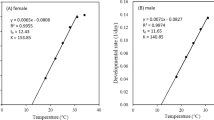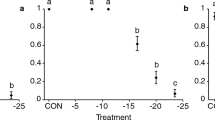Abstract
The lower developmental temperature threshold (T 0) and the Degree Days (DD) required for the encyrtid endoparasitoid Anagyrus ananatis Gahan to develop from egg to adult on the pink pineapple mealybug (PPM), Dysmicoccus brevipes (Cockerell) (Hemiptera: Pseudococcidae), were determined. The T 0 was estimated to be about 12.65 °C for both females and males. In contrast, females and males required about 275 and 265 DD, respectively, to complete development from egg to adult. Temperatures from 19 to 29 °C were optimal for mass rearing of A. ananatis, with the optimal temperature being around 24 °C. At this temperature, A. ananatis could complete almost two generations in the time it takes PPM to complete only one generation. Although A. ananatis is a koinobiont, the mealybug host was killed within a few (6–8) days after parasitization. The developmental stages of A. ananatis were described (e.g., appearance, size, color) and their time periods quantified when reared on PPM at 23.5 ± 0.5°C. Encyrtiform eggs were inserted through the dorsal surface of the PPM and were attached to the host via a slender stalk. This immature parasitoid remained attached to the host cuticle via the stalk until entering the prepupal stage. The host mealybug mummified during the parasitoid’s prepupal stage. First adult eclosion occurred at 24 days post-parasitization.
Similar content being viewed by others
Abbreviations
- Δr :
-
Change in developmental rate
- D:
-
Days
- DD:
-
Degree days
- DT:
-
Days to complete development × incubation temperature
- GPM:
-
Gray pineapple mealybug
- K :
-
Total accumulated temperature
- PPM:
-
Pink pineapple mealybug
- r :
-
Rate of parasitoid development
- r 1 :
-
Rate of development at lower temperature
- r 2 :
-
Rate of development at higher temperature
- T :
-
Temperature regime
- T 0 :
-
Lower developmental threshold
References
Andrewartha H.C. and Birch L.C. (1954). Distribution and Abundance of Animals. University of Chicago Press, Chicago
Bartlett B.R. (1978). Pseudococcidae. In: Clausen, C.P. (eds) Introduced Parasites and Predators of Arthropod Pest and Weeds: A World Review, pp 137–171. U.S. Department of Agriculture, Handbook No. 480, Washington, D.C
Beardsley, J.W., 1993. The pineapple mealybug complex: taxonomy, distribution and host relationships. In: D.P. Bartholomew and K.G. Rohrbach (eds), Proceedings, First International Pineapple Symposium, 2–6 November, 1992 Honolulu, Hawaii. Acta Horticulturae 334: 383–386
Bokonon-Ganta A.H., Van Alphen J.J.M. and Neuenschwander P. (1996). Competition between Gyranusoidea tebygi and Anagyrus mangicola, parasitoids of the mango mealybug, Rastrococcus invadens: interspecific host discrimination and larval competition. Entomol. Exp. Appl. 79: 179–185
Briere J.F., Pracos P., Roux A.Y.L. and Pierre J.S. (1999). A novel rate model of temperature dependent development for arthropods. Environ. Entomol. 28: 22–29
Campbell A., Frazer B.D., Gilbert N., Gutirrez A.P. and Mackaure M. (1974). Temperature requirement of some aphid and their parasites. J. Appl. Ecol. 11: 431–438
Carter W. (1937). Importation and laboratory breeding of two chalcid parasites of Pseudococcus brevipes (Ckl.). J. Econ. Entomol. 30: 370–372
Clausen C.P. (1940). Entomophagus Insects. McGraw Hill Book Co., New York, NY
Collins J.L. (1960). The Pineapple: Botany, Cultivation and Utilization. Leonard Hill, London,, 295 p
Cross A.E. and Moore D. (1992). Developmental studies on Anagyrus mangicola (Hymenoptera: Encyrtidae), a parasitoid of the mealybug Rastrococcus invadens (Homoptera: Pseudococcidae). Bull. Entomol. Res. 82: 307–312
Davidson J. (1944). On the relationship between temperature and rate of development of insects at constant temperatures. J. Animal Ecol. 13: 26–38
De Santis L. (1964). Encirtidos de la Republica Argentina (Hymenoptera: Chalcidoidea). Anales de la Comisión de Investigación Cientifica Provincia de Buenos Aires Gibernación 4: 9–422
De Santis, L., 1979. Catalogo de los Himenopteros Chalcidoideos de America al Sur de los Estados Unidos. Publicacion Especial Comisión de Investigaciones Cientificas Provincia de Buenos Aires. 488 p
De Santis L. (1980). Catalogo de los Himenopteros Chalcidoidea Brasilenos de la serie Parasitica incluyendo Bethyloidea. Editora da Universidade Federal do Parana, Curitiba, 395
Funasaki G.Y., Lai P.Y., Nakamura L.M., Beardsley J.W. and Ota A.K. (1988). A review of biological control introductions in Hawaii 1890–1985. Proc. Hawaiian Entomol. Soc. 28: 105–160
González-Hernández H. (1995). The Status of Biological Control of Pineapple Mealybugs in Hawaii. Ph.D Dissertation, University of Hawaii at Manoa, Honolulu, Hawaii
González-Hernández H., Johnson M.W. and Reimer N.J. (1999a). Impact of Pheidole megacephala (F.) (Hymenoptera: Formicidae) on the biological control of Dysmicoccus brevipes (Cockerell) (Homoptera: Pseudococcidae). Biol. Control 15: 145–152
González-Hernández H., Reimer N.J. and Johnson M.W. (1999b). Survey of the natural enemies of Dysmicoccus mealybugs on pineapple in Hawaii. BioControl 44: 47–58
González-Hernández, H., R.R. Pandey and M.W. Johnson, 2005. Biological characteristics of adult Anagyrus ananatis Gahan (Hymenoptera: Encyrtidae), a parasitoid of Dysmicoccus brevipes (Cockerell) (Hemiptera: Pseudococcidae). Biol. Control (In press)
(2001). List of Active SLN Registration. Pesticide Branch, Hawaii Department of Agriculture, Honolulu, HI
Honek A. (1996). Geographical variation in thermal requirements for insect development. Eur. J. Entomol. 93: 303–312
Ikemoto T. and Takai K. (2000). A new linearized formula for the law of total effective temperature and the evaluation of line-fitting methods with both variables subject to error. Environ. Entomol. 29: 671–682
Islam K.S. and Jahan M. (1993). Oviposition and development of the mealybug parasitoid Anagyrus pseudococci (Girault) at different constant temperatures. Pakistan J. Sci. Indust. Res. 36: 322–324
Ito K. (1938). Studies on the life history of the pineapple mealybug Pseudococcus brevipes (Ckll.). J. Econ. Entomol. 31: 291–298
Kishore R., Kumar P., Manjunath D. and Datta R.K. (1994). Effect of temperature on the developmental period, progeny production and longevity of Tetrastichus howardi (Olliff) (Hymenoptera: Eulophidae). J. Biol. Control 8: 10–13
Kotinsky J. (1910). Coccidae not hitherto recorded from these islands. Proc. Hawaiian Entomol. Soc. 2: 127–131
Lide D.R. (1993). CRC Handbook of Chemistry and Physics. CRC Press, Boca Raton
Lohr B., Santos B. and Varela A.M. (1989). Larval development and morphometry of Epidinocarsis lopezi (DeSantis) (Hym., Encyrtidae), parasitoid of the cassava mealybug, Phenacoccus manihoti Mat.-Ferr. (Hom., Pseudococcidae). J. Appl. Entomol. 107: 334–343
Noyes J.S. and Hayat M. (1994). Oriental Mealybug Parasitoids of the Anagyrini (Hymenoptera: Encyrtidae). Natural History Museum/CAB International, London
Odebiyi J.A. and Bokonon-Ganta A.H. (1986). Biology of Epidinocarsis (=Apoan- agyrus) lopezi (Hymenoptera: Encyrtidae), an exotic parasite of Cassava mealybug Phenacoccus manihoti (Homoptera: Pseudococcidae) in Nigeria. Entomophaga 31: 251–260
Pandey R.R. (2002). Mass production of Anagyrus ananatis Gahan (Hymenoptera: Encyrtidae) for the augmentative biological control of pink pineapple mealybug Dysmicoccus brevipes (Cockerell) (Homoptera: Pseudococcidae). Ph.D. Dissertation, University of Hawaii at Manoa, Honolulu, HI, USA
Pandey, R.R. and M.W. Johnson, 2005. Effects of cool storage on Anagyrus ananatis Gahan (Hymenoprtera: Encyrtidae). Biol. Control (In Press)
Pemberton L. (1964). Highlights in the history of entomology in Hawaii 1778–1963. Pac. Insects 6: 689–729
Rohrbach K.G., Beardsley J.W., German T.L., Reimer N.J. and Sanford W.G. (1988). Mealybug wilt, mealybugs, and ants of pineapple. Plant Dis. 72: 558–565
Sagarra L.A., Vincent C., Peters N.F. and Stewart R.K. (2000). Effect of host density, temperature, and photoperiod on the fitness of Anagyrus kamali, a parasitoid of the hibiscus mealybug Maconellicoccus hirsutus. Entomol. Exp. Appl. 96: 141–147
(1999). The SAS System for Windows. Release 8.0. SAS Institute, Cary, NC, USA
Sether D.M., Ullman D.E. and Hu J.S. (1998). Transmission of pineapple mealybug wilt-associated virus by two species of mealybug (Dysmicoccus spp.). Phytopathology 88: 1224–1230
Swezey O.H. (1939). Recent records of the introduction of beneficial insects into the Hawaii islands. Proc. Hawaii. Entomol. Soc. 10: 349–352
Tingle C.C.D. and Copland M.J.W. (1988). Predicting development of the mealybug parasitoids Anagyrus pseudococci, Leptomastix dactylopii and Leptomastidae abnormalis under glasshouse conditions. Entomol. Exp. Appl. 46: 19–28
Williams D.J. and Watson G.W. (1988). The Scale Insects of Tropical South Pacific Region. CAB International, Wallingford, 260 p
Author information
Authors and Affiliations
Corresponding author
Rights and permissions
About this article
Cite this article
Pandey, R.R., Johnson, M.W. Physiological and morphological development of Anagyrus ananatis at constant temperatures. Biocontrol 51, 585–601 (2006). https://doi.org/10.1007/s10526-005-2156-2
Received:
Accepted:
Published:
Issue Date:
DOI: https://doi.org/10.1007/s10526-005-2156-2




